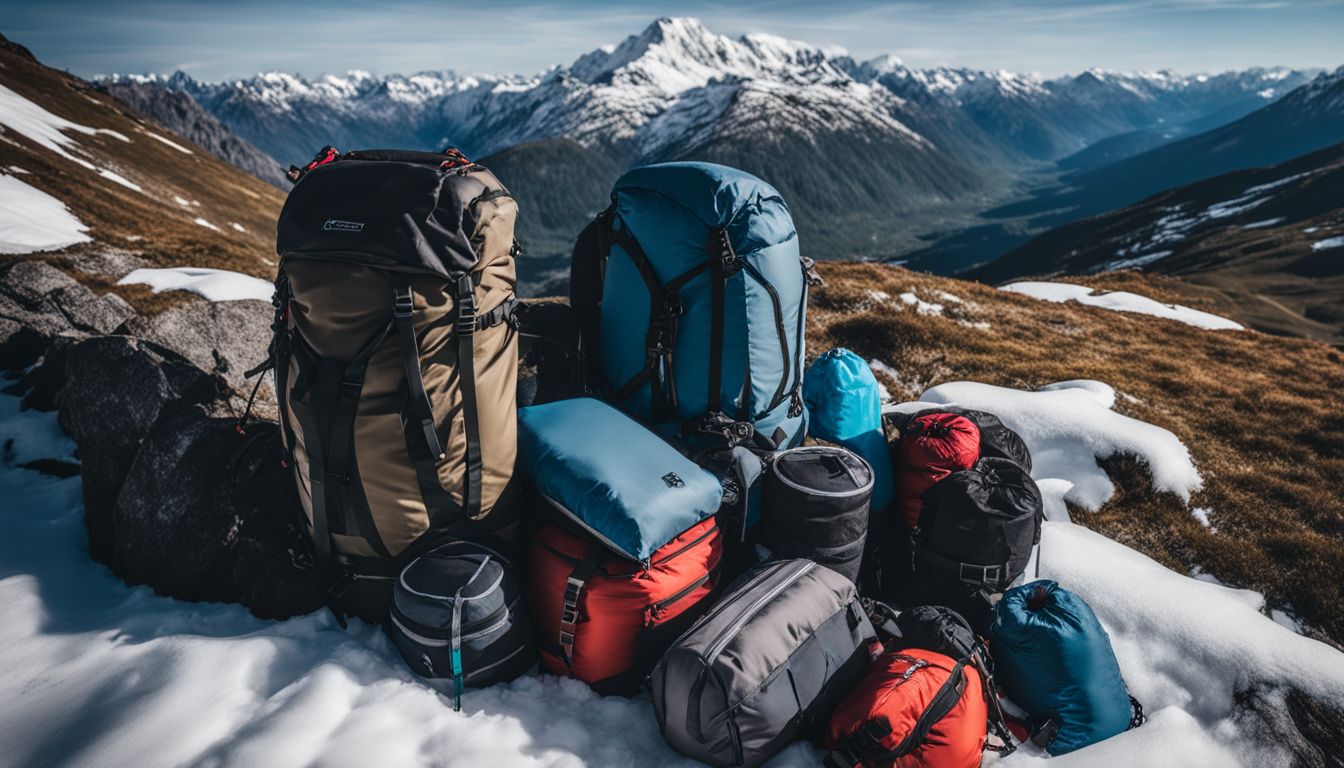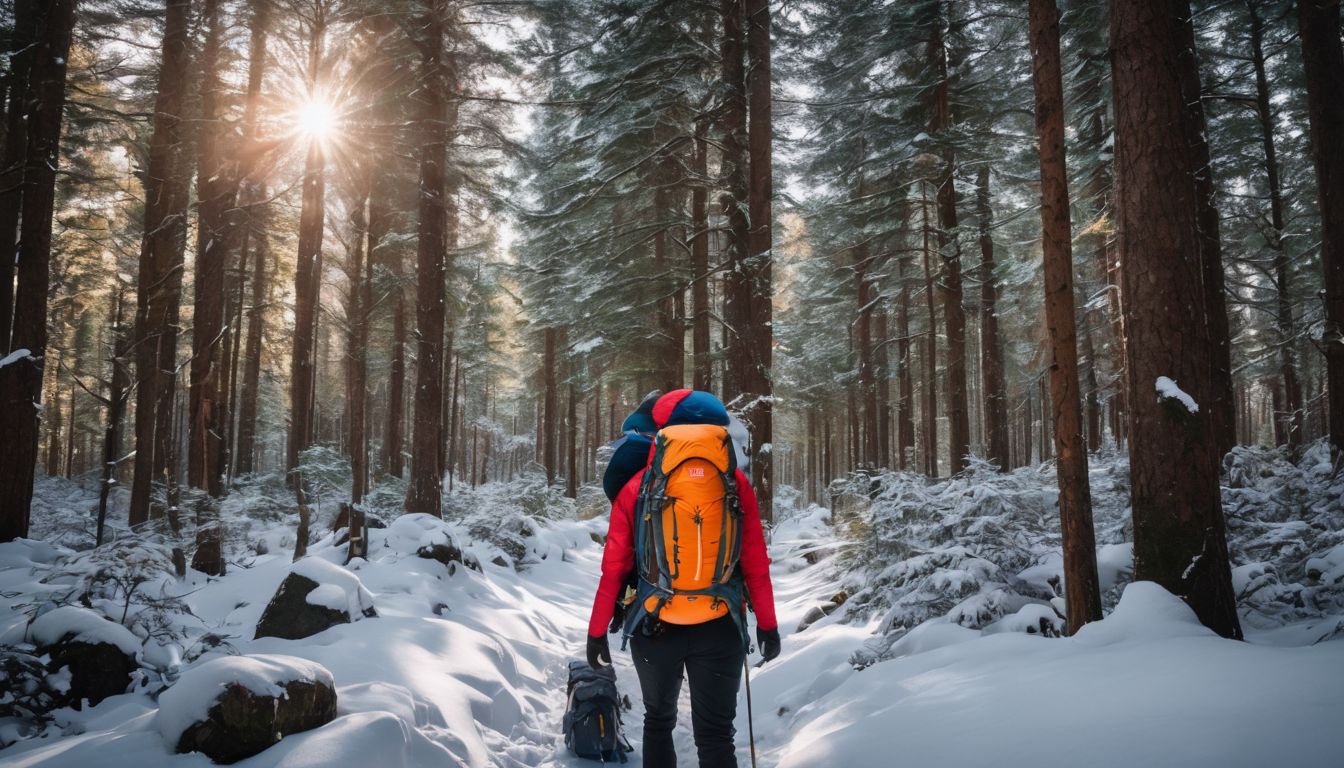Winter treks demand more than just a sense of adventure; they call for meticulous preparation and the right gear. With years of experience hiking snowy trails, I’ve learned that packing smart is the secret to enjoying the majesty of a winter landscape safely and comfortably.
Packing for cold-weather journeys isn’t just about piling on layers – it’s an artful balance between essentials and weight management, ensuring you carry what you need without being weighed down.
Every seasoned adventurer knows a reliable rucksack is your lifeline in the wilderness, especially when temperatures drop. The key lies in choosing versatile items like merino wool base layers and water-resistant goose down jackets to brave nature’s harshest elements.
As we dive into this guide, remember: effective packing can mean the difference between battling hypothermia and relishing a serene snowfall beside your campfire. Stay prepared, stay safe, keep reading!
Key Takeaways
- The key to enjoying a winter trek is smart packing, focusing on essentials like a sturdy backpack, reliable shelter, and warm sleeping system.
- Dressing in layers using merino wool or synthetic base layers, fleece jackets, and water – resistant coats helps maintain warmth and adapt to changing weather conditions during winter hikes.
- Using compression sacks for bulky items and packing cubes for organization maximizes space in your rucksack for efficient packing. Additionally, wearing bulky clothing while traveling can free up space in your backpack.
- Prioritize safety by including traction devices for footwear and insulation like down jackets and thermals. Distribute weight evenly in the rucksack; pack essential emergency items such as first-aid supplies, extra food/water, navigation tools, ID documents and emergency contacts for unexpected situations.
Essential Winter Backpacking Gear

When preparing for winter backpacking, it’s crucial to focus on the big three: a sturdy backpack, reliable shelter, and a warm sleeping system. Additionally, layering your clothing for warmth and versatility is essential in cold weather conditions.
The Big Three: Backpack, Shelter, Sleeping System
Packing light is key for winter adventures, and the Big Three: your backpack, shelter, and sleeping system often make up most of the weight. Even in cold weather, you can find gear that’s both warm and lightweight.
Choose a rucksack that fits well and holds everything you need without being too heavy. Your shelter keeps you safe from wind and snow; look for one designed for winter conditions but doesn’t add too much weight to your load.
A good sleeping bag should keep you cozy when temperatures drop. Pair it with an insulated sleeping pad to prevent heat loss to the ground. These items are critical because they ensure a warm night’s sleep after a long day of hiking or snowshoeing.
The right clothing helps too! Next up is how to dress smartly for chilly trails by layering clothes effectively.
Clothing: Layering Strategy for Warmth and Versatility
After you’ve chosen your backpack, shelter, and sleeping system, the next step is figuring out what to wear. Dressing in layers is key for staying warm and ready for any weather during winter trips.
Start with a base layer made of merino wool or synthetic materials that pull sweat away from your skin. This keeps you dry and warm.
Add more layers on top of your base layer to trap body heat. Thin clothes work better than thick ones so you can take off or put on layers easily as the temperature changes. Think about wearing a fleece jacket or a wool sweater over your base layer.
Always finish with a water-resistant coat to protect against wind and snow.
Don’t forget about your legs! Wear long underwear under a pair of hiking pants for extra warmth. And accessories matter too – use hats, gloves, gaiters, and wool socks to cover up every part of you from the cold weather outside.
With this strategy, you’ll be set to trek through snow while keeping cozy and mobile!
Packing Efficiently for Winter Travel

When it comes to packing for winter travel, using compression sacks for bulky items and packing cubes for organization can make a big difference. These tools help maximize space in your rucksack and keep your gear neatly arranged for easy access on the go.
Compression Sacks for Bulky Items
Packing for winter means dealing with big, fluffy items like sleeping bags and coats. Compression sacks are great because they squish these things down to a third of their size. You slide your puffy gear inside, seal the sack, and press out all the air.
Suddenly, you have more room in your rucksack! These sacks also keep things dry and organized.
Choosing lightweight compression sacks helps a lot too. They squash bulky stuff without adding extra weight to your bag. Imagine fitting that huge winter jacket into a tiny bundle next to your hiking boots! This trick lets you pack smarter and brings everything you need without feeling weighed down or messy.
Now let’s talk about how packing cubes can make things even neater inside your rucksack.
Use of Packing Cubes for Organization
When it comes to efficiently organizing your winter gear, packing cubes can be a game-changer. Packing cubes are not just for clothes; they’re versatile and perfect for keeping all your items well-organized, from climbing gear to toiletries.
Regular packing cubes are great for neatly arranging your clothing, while compression cubes are worth the investment for bulky winter items like sweatshirts and gortex jackets. By using packing cubes strategically, you’ll maximize luggage space and keep everything in order throughout your winter adventure.
Packing cubes offer practical benefits such as efficient space utilization and wrinkle-free organization. They let you pack similar items together, optimizing space inside your rucksack.
Gear for Winter Safety and Comfort
When venturing into winter terrain, it’s crucial to have the right gear for safety and comfort. Traction devices for footwear provide stability on snow and ice, while insulation like down jackets and thermals keep you warm in cold temperatures.
Traction Devices for Footwear
Ensure winter safety and comfort with traction devices for footwear. Microspikes, ice cleats, snow grips, and crampons are top choices. They attach easily to shoes for improved grip on icy surfaces during winter hiking or trekking.
Some traction devices are best suited for specific footwear types, so it’s important to choose the right gear based on your needs.
Choosing the correct traction device is crucial – consider factors such as weight, packability, and compatibility with your hiking or running shoes. Each option has its own advantages; for example, microspikes are lightweight and multifunctional while ice cleats provide reliable grip.
Prioritize your specific requirements when selecting a traction device to enhance safety during winter outdoor activities.
Insulation: Down Jackets and Thermals
When it comes to staying warm in cold conditions, down jackets and thermals are essential. Down insulation provides excellent warmth while being lightweight and compressible. The unique structure of down feathers creates air pockets that trap warm air, keeping the body insulated from the cold.
It is important to protect down gear from moisture as wet or damp down loses its insulating properties. Therefore, choosing water-resistant options and using proper storage techniques are crucial for maintaining warmth and comfort in winter conditions.
To optimize your winter packing experience, consider selecting items with these valuable characteristics: outsole, tread, soles, rucsack, belaying gloves, sneakers, water bottle.
Tips for Carrying Winter Gear
Distribute weight evenly in your rucksack to avoid strain on your shoulders and back. Wear your bulkiest items, like your down jacket, to free up space in your pack for other gear.
Wear Your Bulkiest Items
Wearing your bulkiest winter clothing, like your coat and boots, while traveling can free up space in your backpack for other essential items. This simple strategy allows you to pack efficiently without sacrificing warmth or comfort during your winter adventure.
By wearing these bulky items instead of packing them, you create extra room in your backpack for important gear and supplies.
When preparing for a cold-weather trip, remember that the key to light packing is to don your heaviest clothing layers. Doing this not only maximizes space in your backpack but also ensures that you stay warm and comfortable when on the move.
It’s an effective way to manage limited storage and keep yourself well-equipped for whatever comes during winter travel.
Distribute Weight Evenly in the Rucksack
To distribute weight evenly in your rucksack, pack heavy items lower to create a stable center of gravity. Wear your bulkiest items, and use a belt that cups over your hip bones for even weight distribution.
Avoid attaching any gear externally, as it may shift the weight away from the center and cause imbalance. Consider using compression sacks for bulky items and packing cubes for better organization inside your rucksack.
Properly distributing weight not only ensures comfort but also enhances safety during winter adventures.
Rucksack Packing for Emergency Situations
When you’re packing your rucksack for emergency situations, make sure to prioritize essential items like first-aid supplies, emergency shelter, and extra food and water. Carry a lightweight emergency blanket, a whistle for signaling, and a multi-tool for versatility.
Also, pack important documents such as identification and emergency contacts in a waterproof pouch. Consider adding some paracord or rope which can be useful in various emergency scenarios.
In an emergency situation, having basic medical supplies like adhesive bandages, antiseptic wipes, pain relievers can be crucial. Additionally, carrying backup fire-starting materials and navigation tools such as a compass or GPS device is essential for ensuring safety in unexpected circumstances.
Conclusion: Preparing for a Winter Adventure
In conclusion, packing your rucksack for a winter adventure requires careful planning. Remember to pack essential items like the big three (backpack, shelter, and sleeping system) before anything else.
Utilize compression sacks and packing cubes to maximize space and stay organized. Prioritize safety by including traction devices for footwear and insulation like down jackets and thermals.
Ensure you distribute weight evenly in your backpack while wearing bulky items for convenience. With these practical tips, you can gear up efficiently and enjoy a safe and comfortable winter outdoor experience.
FAQs
1. What kind of rucksack should I use for winter gear?
Use a water-resistant rucksack to keep your winter gear dry.
2. Why is it important to have a water-resistant bag?
A water-resistant bag helps protect your things from getting wet in the snow or rain.
3. Can all my winter gear fit in one rucksack?
Pack smart and place heavy items at the bottom; you might get everything to fit!
4. How do I make sure my stuff stays dry if it’s snowing?
Make sure your rucksack is closed tight, and cover it with a raincover for extra protection against the snow.

